Granny Dwyer’s Sauce for Steak
February 5, 2008
12:38 PM
Reading Kieran in Ice Cream Ireland today about the search for Granny’s recipes from Mercier Press inspired me to seek out this recipe from my mother.
While my mother was alive this was her ultimate comfort and celebration dish, and as she got it in turn from her mother it certainly qualifies for the “Granny” label.
The sauce, according to my Grandmother, had originally been called Monkey Gland Sauce. It was she claimed, so called because in the 1920’s when it was invented, there was a belief that consumption of monkey glands would grant the consumers longevity.
This particular combination of tomato cream and mushrooms was thought so delicious that it could perform a similar function.
This was their story and both my mother and grandmother stuck to it.
The South Africans, meanwhile have their own version of Monkey Gland Sauce which is a fairly revolting combination of every sauce in the store cupboard thrown onto a pan, a bit like Sweet and Sour meets Barbecue Sauce.
This is not to be confused with our true Granny’s Sauce.
I put this recipe on the menu in my restaurant in Waterford shortly after we opened and it was certainly the most popular sauce for steak there for the fifteen years we were in business.
It was always on the menu as Steak with Granny Dwyer’s Sauce .
I know that the Mercier are hoping for stuff more in the line of Apple Pie and Bacon and Cabbage but this was a true Granny dish, was enjoyed by her seven children, her thirty grandchildren and (I hope will be ) by her (for now) thirty odd great-grand-children.
Steak with Granny Dwyer’s Sauce
4x 225g (8oz.) Steaks (Fillet or Sirloin)
Salt and Pepper
1 Tablespoon Olive Oil
175g (6 oz.) Mushrooms
60g (2 oz.). Butter
Squeeze of Lemon Juice
30g (1 oz.) Flour
225g (8 oz.) Vine Tomatoes
225ml (8 oz.) Cream (or Crème Fraiche)
Salt and Pepper
Sauce:
First get ready the tomatoes. Bring a pot of water to the boil and then slip in the tomatoes, put the put into a sink as soon as it comes back to boil and pour in cold water. When they are cool enough to handle slip off the skins and then chop the tomatoes with a large knife into small cubes. Put to one side.
Rub the mushrooms in a clean tea towel to remove any compost (there is no need to wash cultivated mushrooms)
Slice these, Melt the butter in a large pan and cook the mushrooms in this until all their liquid has evaporated and they are starting to go brown.Sprinkle over the lemon juice and then the flour and stir this in.Now put in the chopped tomatoes and bring to the boil stirring all the time.
Next add the cream and again boil and continue simmering for a few minutes.
Now put a pan with a heavy base on to heat and when hot put the oil on . When this is sizzling add the meat to the pan and brown it on one side, then turn it and brown the other.
When cooked for about a minute on each side the steak is rare and ready to serve, you should decrease the heat and continue cooking it, turning from time to to time to cook it as much as you want. (Bear in mind that the more you cook it the more natural moisture it looses and the smaller the steak gets) Once cooked put these on a large plate somewhere warm and reheat the sauce, once hot pour in any juices that will have gathered on the steak plate.
Serve with the sauce poured over the steaks.
2 comments
The Un-Pressure Cooker
February 5, 2008
10:23 AM
Anyone who passed through the rigours of the Irish education system can recognise how a bully, even one who is in a position of power, operates.
The notion that control can be achieved only through intimidation and (in sixties Ireland) by actual beatings, is a common assumption in our education system.
Unfortunately the same is true in the traditional training of kitchen staff.
Not too many years ago we were allowed to observed the horrific and even sometimes physically dangerous treatment meted out to unfortunate commis chefs in English kitchens.
That these kitchens were producing starred Michelin food is to me irrelevant.
My original training in Snaffles in Dublin, although extremely hard work, was never enforced by either abuse or brutality.
When I moved to France and worked for a few months in the Loire area I met with this for the first time. There I met a chef who because he had been trained in the kitchen from hell felt obliged to do the same in his own kitchen.
I would prefer to forget my time there.
From there I went to work in a kitchen in Kent where the boss, Michael Waterfield, also the head chef, treated all his staff with kindness and politeness, and where it was a pleasure to work.
This kitchen please note produced delicious food which was recognised as the best in the South East of England at that time.
When I got around to running my own restaurant in Waterford in the nineties I resolved to run it as Michael Waterfield had done.
That I succeeded in running an amicable kitchen I think could be evidenced by a staff party last Sunday, three and a half years after the restaurant closed, where it was obvious that we were still all great friends. (I rather fear that we all laughed so much we may have prematurely cleared the restaurant we were meeting in)
I always remember a constant customer (a priest in fact) saying that he loved to hear the laughter coming from the kitchen in Dwyers when he dined. Not very professional I know but surely an improvement on streams of abusive language coming from the stove.
I have to add at this stage that Dwyers was an extremely successful restaurant, rated in Irelands top ten by John Mc Kenna and Sunday Business Post’s Ross Golden Bannon as well as achieving (unfortunately only after we had closed) a “worth a detour” from the Michelin Guide.
I suppose all this is leading up to The Pressure Cooker and the televised shenanigans in the kitchen as chef Dylan Mc Grath achieved his Michelin Star.
Personally I think of this star, achieved by fear and bullying, in much the same light as the German Autobahns or the trains in Italy running on time during Mussolini’s reign.
If this is the only way these things can be achieved (and I doubt this) then they probably aren’t worth it.
Molvene
February 4, 2008
22:12 PM
This is from Good Housekeeping Magazine from 1924.
It just about says it all, I just wish I could come across some Molvene, anyone got some left?

1 comment.
Pommes Anna
February 4, 2008
12:29 PM
This is a bit of a flash back to seventies dinner parties but a hell of a good one.
It is perfect dinner party food because it is fiddle enough to be fancy and yet will hang about,waiting for guests to be ready to eat without noticeable deterioration.
It is handy if you have a food processor with a slicer, or, an old fashioned mandoline but they are sufficiently forgiving to be done by hand if you haven’t.
I cook them in an old cast iron frying pan, with an oven proof handle , which looks good on a table, but a cake tin or quiche tin would do the trick.
They don’t always come out of the cooking container easily so it is good to have something you can put on the table and let people help themselves.
The herbs aren’t in the original classic recipe but I like them in it.
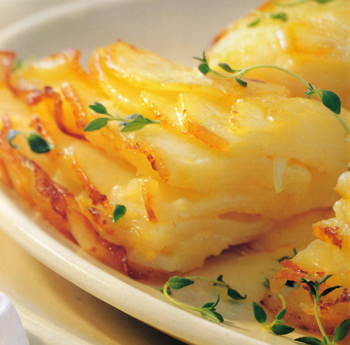
Recipe
1 kg (2 lbs) peeled potatoes(I used Records and they worked well)
90g (3 oz.) Melted Butter
1 Tablespoon chopped fresh thyme
1 Tablespoon chopped fresh chives
Plenty of salt and fresh black pepper.
Slice the potatoes as evenly and as thinly as you can.
If they are very floury it would be worth while giving them a quick rinse in some cold water and a pat dry.
Put the sliced potatoes in a bowl, melt the butter and pour this on them then sprinkle over the herbs and the salt and pepper.
Now work the butter through the potatoes with your fingers so that the slices are all coated and the herbs and seasonings are well dispersed.
Scatter these fairly evenly into your (well buttered) cooking utensil and press them down together.
Cover these with tin foil and heat the oven to 200C,400F, Gas 6.
Cook covered at this tempersture then take off the cover and cook for a further 15 to 20 minutes uncovered.
The top layer should get crusty, the potatoes tender when poked with a knife.
It can be handy to cook them up to the uncovering stage earlier in the day and put them into a hot oven to brown for about 20 mts before you eat.
Turn them out on to a plate if you can, otherwise serve in the container.
2 comments
Post Codes
February 4, 2008
10:27 AM
Is no-one but me infuriated by the worlds assumption that we, in Ireland, must have post codes.
So many times have I been stymied in my attempts to move through websites, mainly where I want to SPEND money by their peremptory demand for my post code.
Admittedly they are usually fobbed off by any jumble of letters and numbers but just occasionally they are not and the ensuing frustration does aggravate.
My dealings with IKEA in December have brought this to my personal peak of exasperation.
I wrote to them for a gift voucher to give to my daughter and son-in-law as I knew they were keen to make the trip to the new Belfast outlet.
After about two weeks of deafening silence, having made all the right noises on the phone, I got a hand written note from Ikea saying that they couldn’t process vouchers from Ireland as we don’t have post codes.
The same handwritten letter arrived to me in perfect time and perfectly addressed and, of course, without a post code.
5 comments
Glazed Lime Tart
February 1, 2008
11:37 AM
I think I originally stole this from a Dennis Cotter book, but his was lemon not lime and the brulee top is my own.
It was a signature dish in the restaurant, a fiddle to make but certainly worth it.
As it is a fiddle I have decided to be gracious and give you all a few pictures to help you on your way.
Glazed Lime Tart
(You will need a 20cm.( 9 ins.) Tart Tin)
Pastry:
110g (4 oz.) Flour
60g (2oz.) Caster Sugar
60g (2oz.) Butter
3 tablespoons water
Filling:
3 Limes
150g (5 oz.) Caster Sugar
2 Whole Eggs
4 Egg Yolks
110g (4 oz.) Unsalted Butter.
First make and bake the tart base.
Rub in the flour and the butter by hand or in the food processor.
Add the water and blend to form a paste.
Leave to rest then roll out and use to line a tart or quiche tin.
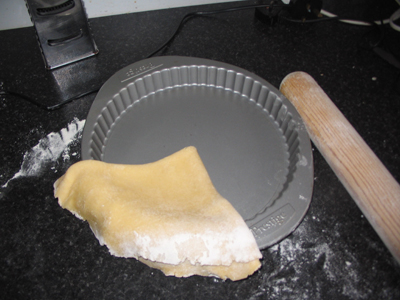
If you quarter the pastry like this you can make sure you place it dead centre and then you don’t risk it breaking as you put it into position.
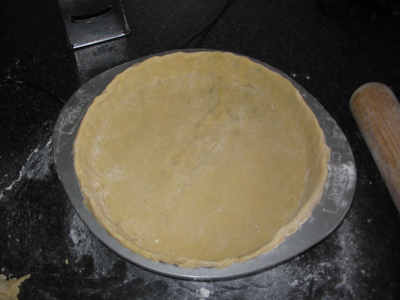
Always allow a surplus of pastry over the edge of the tin. This gives you a safety net in case it shrinks.
Cover with parchment and some weights and bake blind at Gas 5, 190C,375F for 10 mts to cook.
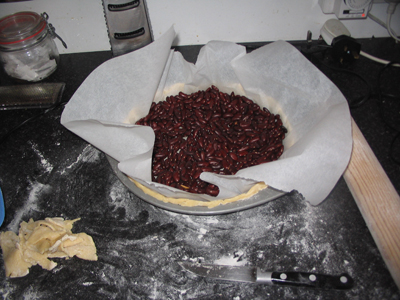
I have an old batch of, now dessicated, haricots which I keep specifically for this job
Take off the parchment and bake for another 5 mts until it turns a biscuit brown.
Let it cool.
Filling:
Grate and squeeze the limes and put this with sugar, eggs, and egg yolks into a bowl on top of a pot of barely simmering water.
Melt the butter in another pot.
On the heat beat the sugar, limes and eggs with a whisk or a hand held electric beater for about 4 to 5 mts until they thicken.
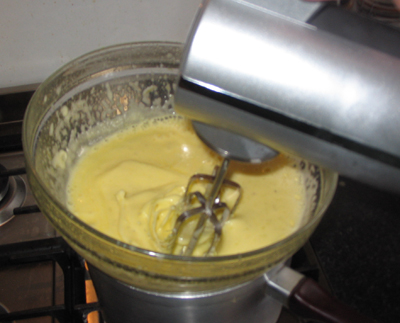
Then take off the heat and, while still beating, add the melted butter in a slow stream.
Then continue beating until the mixture again thickens and cools (At least you can do this off the heat)
Now set the oven to Gas 8, 230C, 450F .
Pour the filling into the tart case and bake at the set temperature for 10 mts.take out of the oven and leave cool.
Once its cool set the grill on to hottest. Sprinkle a thin layer of caster sugar on the top of the tart and put under the hot grill until the sugar browns and melts. Keep your eye on it and turn about to make sure it doesn’t blacken and burn. Now let it cool again before serving.
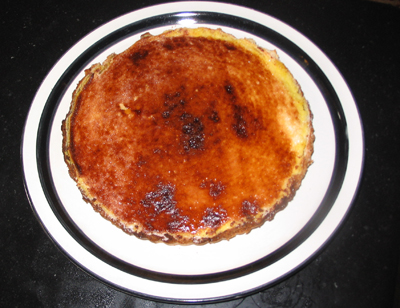
You may have to trim off the top of the pastry if it becomes too browned under the grill.
I think this is possibly my favourite pudding, the crisp crackling caramel top, the soft creamy filling, sharp and sweet with the limes, and the short crisp pastry
It just has it all!
1 comment.
Slippery when Wet
January 31, 2008
14:42 PM
Scene:
Church Baptismal Font surrounded by a full family all in their sunday best
all the faces expressing horror and frozen shock.
In the middle leaning over the font is the young curate, sleeve of surplice rolled up to his shoulder fishing for something in the water.
His face expressing profound embarrassment he speaks;
“Slippery little buggers aren’t they!”
I remember seeing this cartoon somewhere in my youth and it has never left me.
I wish I could find someone to draw it.
Granny’s Christmas Cactus
January 31, 2008
10:10 AM
My mother always loved eating out, I think it was because the business of producing savoury food, as against cakes and desserts, never really appealed to her.
From the time I started the restaurant in Waterford she always enjoyed coming there to eat and, once my father died, and she achieved independence, she would arrive to eat given any excuse whatsoever.She never found the eighty mile drive from Cork to Waterford to be the least hinderance.
I can remember clearly one afternoon in the late nineties telling her that some of her offspring were coming to dinner that night.
“I don’t suppose you wouild have room for another one?” she said, and, once assured of her welcome, hopped straight in the car (she was then in her late eighties!) and was with us a few hours later.
My mother died a few years before we sold the restaurant and moved on.
One of the things that she and Sile shared was a passion for gardening, both indoor and out. Some years before she died she had given Sile a cutting from a Christmas Cactus which had always thrived in her house in Cork, it likewise thrived in Mary Street in Waterford and always came out in nice time for Christmas, covered in flowers.
In fact it did so well Sile devided it in two and when we sold the restaurant she gave one half of the plant to my sister D. It also thrived for her in her house in Fountainstown.
Once we moved to Griffith Place , post restaurant,our half of the Christmas Cactus sulked and since 2004 it has sat stubbornly on a shelf, perfectly healthy, but adamantly refusing to flower.
Last May there was the faintest sign of a thaw and it produced one single blossom.
This Christmas again none.
Two weeks ago Sile pointed out that the cactus was showing signs of life and last week it produced a display of flowers, not up to its Mary Street standard but by far the best in the nearly four years we have been in Griffith Place.
I texted my sister, who having acquired the flowering offspring of the cactus was aware of our ones barren condition.
“Christmas Cactus flowered at last” I texted.
She replied;
“Delighted ! Mum must has decided to forgive you. ”
I suppose it took a while for the news of another potential eatery in France to filter up to her.

The Christmas Cactus this morning.
A Match Made in Heaven
January 30, 2008
13:59 PM
All this talk about chickens lately has given me an appetite for some and I find myself revisiting some of my old chicken recipes from the past.
Tarragon Chicken has long been a French classic, the combination of moist chicken and the fresh lemonyness of tarragon being a winning pairing.
I have always preferred the version of this recipe which slowly cooked the chicken in the sauce thereby giving one tender, falling off the bone chicken imbued with the flavour of the herb.
As our French house is quite near Marseillan in Languedoc, where Noilly Prat Vermouth is made, we have a bottle in the cupboard at the moment so that fairly inevitably got thrown in.
Here is my classic Tarragon Chicken recipe, (as I slowly cook it I prefer to use just chicken legs as I find that breasts given the same treatment get dried up and stringy)
Chicken with Tarragon and Vermouth
(for 4)
4 Legs Free Range Chicken
30g (1 oz.) Butter
1 Glass White Vermouth
2 Tablespoons White Wine Vinegar
1 Tablespoon Fresh Tarragon Leaves
Reserve 1 Teaspoon chopped Tarragon
175ml (6 oz.) Cream
1 Tablespoon Lemon Juice
Divide the legs into drumsticks and thighs and season with salt and black pepper.
Melt the butter in a frying pan and brown the chicken pieces all over in this,
Take the pieces out of the pan and pour off most of the fat.
Deglaze the pan with the vermouth and the vinegar.
Put the chicken and the cream back into the pan, add in the tarragon, roughly chopped, and cover.
Simmer these gently together for about twenty minutes..
(cut into the chicken to make sure it is cooked)
Take out the chicken and keep it warm.
Add the lemon juice to the pan and boil with out the lid to thicken the sauce a little.
Pour this over the chicken as you serve and sprinkle over the reserved teaspoon of Tarragon.
Serve with rice or small new potatoes.
But that covers just one partner in the match.
For the roots of my acquaintance with the other half I have to go back a bit.
In 1976 I worked for a month one summer on the Galley, the floating restaurant which went up and down the Barrow from New Ross.
The chef on board was Paddy Cunningham, a young man trained by Myrtle Allen in Ballymaloe and made famous in her classic cookbook as the commis who fled from her in alarm when she tried to toss a souffle omelette on to a platter he was holding.
(Paddy incidentally totally denied this)
We were to have a mushroom soup on the Galley and to my amazement, in this age of liquidizers, Paddy proceeded to empty the mushrooms on to the chopping board and chop away at them with a large knife.
“This is how Mrs. Allen showed me how to do this” was his only answer when I asked him why he was doing this job by hand.
Mrs. Allen was –of course- quite right.
The wonderful texture of the, inevitably uneven, chopping of the mushrooms added hugely to the soup.
I have never liquidized a mushroom soup since.
In my own restaurant I discovered an affinity between mushrooms and fresh tarragon and the resulting soup became such a feature on the menu at Dwyers that customers used to complain at its absence.
So, here comes the bride…..
Mushroom and Tarragon Soup
450g (1 lb.) Mushrooms
2 medium Onions
1 Bunch Fresh Tarragon (or 1 Teaspoon Dried)
60g (2 oz.) Butter
60g (2 oz.) Flour
1 tablespoon Lemon juice
1 pt. Milk
1 pt. Chicken Stock
Peel and chop the Onions. Melt the butter over a gentle heat and cook the chopped onion at this heat until soft (this will take 10 mts. or so).
Chop the tarragon and add to the pot. Put out your largest chopping board and chop the mushrooms roughly with a large chopping knife until they are in rough dice (their roughness adds to the texture of the soup).
Add these to the pan, increase the heat and cook briskly until the mushrooms are soft and most of their liquid has evaporated.
Meantime bring the milk and stock to the boil together.
Add the flour to the mushrooms and stir in well. Add the boiling stock and milk to the soup and bring it back to the boil stirring all the time.
Taste and season with salt and black pepper and the lemon juice.
Let it simmer for 10 mts. and serve.
And so back to last week when I was cooking up the legs of a chicken for supper one night. I went to the fridge to collect the fresh tarragon I had bought specifically for the purpose that morning and spotted four large mushrooms, the kind known as breakfast mushrooms, sitting there.
That was when I decided to matchmake.
Like all good marriages I rather think both parties are improved by the match.
Chicken with Mushrooms, Tarragon and Vermouth
(for 4)
4 Legs Free Range Chicken
60g (2 oz.) Butter
4 Scallions
4 Large.(Breakfast) Mushrooms
1 Glass White Vermouth
1 Tablespoon Lemon Juice
1 Tablespoon Fresh Tarragon Leaves
Reserve 1 Teaspoon chopped Tarragon
175ml (6 oz.) Crème Fraiche (buy the low fat one)
Divide the legs into drumsticks and thighs and season with salt and black pepper.
Melt the butter in a frying pan and brown the chicken pieces all over in this.
Take these out of the pan and put to one side.
Chop the scallions finely and soften these gently in the pan.
Put the mushrooms on a large board and chop with a large knife until fairly fine but still roughly chopped.
Cook these with the scallions until they too are soft and have reabsorbed their own juices.
Add the vermouth,the roughly chopped tarragon and the lemon juice to the pan.
Put the chicken back into the pan and cover.
Simmer these gently together for about twenty minutes..
(cut into the chicken to make sure it is cooked)
Put the chicken on to warm plates.
Add the Crème Fraiche to the vegetables in the pan and boil fast until this thikens a little, spoon this over the chicken and sprinkle over the reserved teaspoon of tarragon.
Serve with rice or boiled potatoes.
Run Chicken Run
January 30, 2008
12:40 PM
My family were reared in suburban Cork with a house big enough to have a chicken run, so we always enjoyed our own chickens and eggs.
The chickens were a Sunday treat, usually boiled , and eked out with some boiled ham or bacon and fairly inevitably served with a parsley or an egg sauce-and very delicious it was too.
I think it was only when my eldest sister came back from a stint as an au pair in the south of France that I realised how good a chicken which was roasted with just a sprinkle of olive oil (bought from the chemist) could be.
When cheap chickens came in the sixties and seventies I, like everyone embraced them. For an impoverished student the ability to buy a whole chicken, enough for four entire meals, for £0.19s. 6p (about €1.50 in today’s money) was cheap even then.
The fact that the residual flavour of fish from the birds needed copious amounts of curry powder to make them palatable was irrelevant, (they needed the curry powder, and the pineapple chunks which went with them, to make them tasty anyway)
It was after I married and we were on holidays in Italy that the transformation which had happened to chickens finally dawned on me.
We were in a rented house in Tuscany and went to the local market to buy lunch.
We bought a chicken and I stuffed it into the oven to roast.
After a while my wife came out to me in some concern, she said there was a strange smell from the oven, she was wondering if the chicken was “off ”
I went into the kitchen and was immediately carried back to our kitchen in Cork and the wonderful smell of fresh roasting chicken.
I was easily able to reassure Sile and we all thoroughly enjoyed the wonderful flavour of that Italian, slow grown, organic, free range chicken.
The whole process of moving from our own chickens to the battery ones had been sufficiently gradual that I had completely forgotten how good a real chicken could taste.
For years it was one of our great treats when hitting France to buy chicken in the markets and then roast them just with olive oil and whole cloves of garlic which we would squeeze like toothpaste over the chicken before eating.
These chickens were never cheap, not an everyday food but really appreciated when we bought them.
I never really thought too much about the rearing of battery birds so it wasn’t until I saw Hugh Fearnley Whittingstall’s “Chicken Out” series this month that I saw the appalling conditions in which the unfortunates were reared.
The trouble now is that having developed a conscience about one animal where is it going to stop. Pigs I gather have a fairly rough time being reared for the table, I have seen the Belgian method of raising their Bleu de Belge cattle and it is not a pretty site.
They say that lambs don’t respond to intensive farming methods and I have a feeling that ducks wouldn’t put up with 25 to a cage like the hens did.
I am beginning to think we need more information.
So Mr. Hugh F.W. after Chicken Run can we please have Pig Sty, Cow Byre……
|
